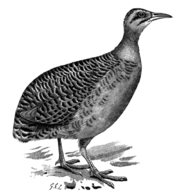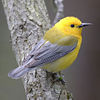Tinamou
| Tinamou | ||||||||||||
|---|---|---|---|---|---|---|---|---|---|---|---|---|
 Great Tinamou, Tinamus major
|
||||||||||||
| Scientific classification | ||||||||||||
|
||||||||||||
| Genera | ||||||||||||
|
Tinamus |
The tinamous are one of the most ancient groups of bird, members of a South American bird family of about 47 species in 9 genera. Although they look similar to other ground-dwelling birds like quail and grouse, they have no close relatives and are classified as a single family Tinamidae within their own order, the Tinamiformes.
Of Gondwanan origin, they are related to the ratites (order Struthioniformes), including the rheas, emu, and kiwi. Although the fossil record in South America is generally poor, the known tinamou fossil record goes back 10 million years.
Together with the ratites, they make up the Paleognathae, or “Old Jaws”, as distinct from the vast majority of modern birds in the Neognathae, or “New Jaws”.
Contents |
Description and ecology
There are 47 species of tinamou in South America and north to Mexico, occurring in a wide range of habitats. They eat a variety of food including insects and berries. The smallest species, the Dwarf Nothura, is about 42 g (1.4 oz) and 15 cm (6 in) long. The largest tinamou, the Gray Tinamou, weighs 1.6 kg (3.6 lb) and measures up to 50 cm (20 in) long.
Tinamous are rarely seen, but often heard within their range. Most inhabit the tropical lowlands of South America, typically in dark, dense forest, but some species range as far north as Mexico and occur in a wide range of habitats. Many species are herbivorous, but some include an amount of insects in their diets[1]. Although some species are quite common, they are shy and secretive. A small number of species live in more open, grassy country, but even these are wary. Although most species are able to fly, they do so relatively poorly, and prefer to escape from danger by hiding in cover or freezing still[1].
Tinamous lay several eggs in a ground nest lined with grass and leaves. The eggs are attractively coloured and have a hard gloss like porcelain. The young are precocial, and can run almost as soon as they hatch.
Species in taxonomic order
FAMILY: TINAMIDAE
- Genus: Tinamus
- White-throated Tinamou, Tinamus guttatus
- Grey Tinamou, Tinamus tao
- Solitary Tinamou, Tinamus solitarius
- T. s. pernambucensis
- T. s. solitarius
- Black Tinamou, Tinamus osgoodi
- T. o. hershkovitzi
- T. o. osgoodi
- Great Tinamou, Tinamus major
- T. m. percautus
- T. m. robustus
- T. m. fuscipennis
- T. m. castaneiceps
- T. m. brunniventris
- T. m. saturatus
- T. m. latifrons
- T. m. zuliensis
- T. m. major
- T. m. olivascens
- T. m. peruvianus
- T. m. serratus
- Genus: Nothocercus
- Highland Tinamou, Nothocercus bonapartei
- N. b. frantzii
- N. b. bonapartei
- N. b. discrepans
- N. b. intercedens
- N. b. plumbeiceps
- Tawny-breasted Tinamou, Nothocercus julius
- Hooded Tinamou, Nothocercus nigrocapillus
- N. n. cadwaladeri
- N. n. nigrocapillus
- Highland Tinamou, Nothocercus bonapartei
- Genus: Crypturellus
- Berlepsch's Tinamou, Crypturellus berlepschi
- Little Tinamou, Crypturellus soui
- C. s. meserythrus
- C. s. modestus
- C. s. capnodes
- C. s. poliocephalus
- C. s. caucae
- C. s. harterti
- C. s. mustelinus
- C. s. caqueta
- C. s. nigriceps
- C. s. soui
- C. s. albigularis
- C. s. inconspicuus
- C. s. andrei
- C. s. panamensis
- Cinereous Tinamou, Crypturellus cinereus
- Tepui Tinamou, Crypturellus ptaritepui
- Brown Tinamou, Crypturellus obsoletus
- C. o. obsoletus
- C. o. griseiventris
- C. o. hypochraceus
- C. o. punensis
- C. o. traylori
- C. o. ochraceiventris
- C. o. castaneus
- C. o. knoxi
- C. o. cerviniventris
- Undulated Tinamou, Crypturellus undulatus
- C. u. undulatus
- C. u. manapiare
- C. u. simplex
- C. u. adspersus
- C. u. yapura
- C. u. vermiculatus
- Pale-browed Tinamou, Crypturellus transfasciatus
- Brazilian Tinamou, Crypturellus strigulosus
- Grey-legged Tinamou, Crypturellus duidae
- Red-legged Tinamou, Crypturellus erythropus
- C. e. erythropus
- C. e. cursitans
- C. e. spencei
- C. e. margaritae
- Magdalena Tinamou, C. (erythropus) saltuarius (taxonomic status presently unclear)
- Santa Marta Tinamou, C. (erythropus) idoneus (taxonomic status presently unclear)
- Colombian Tinamou, C. (erythropus) columbianus (taxonomic status presently unclear)
- Yellow-legged Tinamou, Crypturellus noctivagus
- C. n. noctivagus
- C. n. zabele
- Black-capped Tinamou, Crypturellus atrocapillus
- C. a. atrocapillus
- C. a. garleppi
- Thicket Tinamou, Crypturellus cinnamomeus
- C. c. cinnamomeus
- C. c. occidentalis
- C. c. mexicanus
- C. c. sallaei
- C. c. goldmani
- C. c. soconuscensis
- C. c. vicinior
- C. c. delattrei
- C. c. praepes
- Slaty-breasted Tinamou, Crypturellus boucardi also known as Boucard’s Tinamou
- C. b. boucardi
- C. b. costaricensis
- Choco Tinamou, Crypturellus kerriae
- Variegated Tinamou, Crypturellus variegatus
- Rusty Tinamou, Crypturellus brevirostris also known as Short-billed Tinamou
- Bartlett's Tinamou, Crypturellus bartletti
- Small-billed Tinamou, Crypturellus parvirostris
- Barred Tinamou, Crypturellus casiquiare
- Tataupa Tinamou, Crypturellus tataupa
- C. t. tataupa
- C. t. inops
- C. t. peruviana
- C. t. lepidotus
- Genus: Rhynchotus
- Red-winged Tinamou, Rhynchotus rufescens
- R. r. rufescens
- R. r. catingae
- R. r. pallescens
- Huayco Tinamou, Rhynchotus maculicollis
- Red-winged Tinamou, Rhynchotus rufescens
- Genus: Nothoprocta
- Taczanowski's Tinamou, Nothoprocta taczanowskii
- Ornate Tinamou, Nothoprocta ornata
- N. o. ornata
- N. o. branickii
- N. o. rostrata
- Chilean Tinamou, Nothoprocta perdicaria
- N. p. perdicaria
- N. p. sanborni
- Brushland Tinamou, Nothoprocta cinerascens
- N. c. cinerascens
- N. c. parvimaculata
- Andean Tinamou, Nothoprocta pentlandii
- N. p. pentlandii
- N. p. ambigua
- N. p. oustaleti
- N. p. niethammeri
- N. p. fulvescens
- N. p. doeringi
- N. p. mendozae
- Curve-billed Tinamou, Nothoprocta curvirostris
- N. c. curvirostris
- N. c. peruviana
- Genus: Nothura
- White-bellied Nothura, Nothura boraquira
- Lesser Nothura, Nothura minor
- Darwin's Nothura, Nothura darwinii
- N. d. darwinii
- N. d. peruviana
- N. d. agassizii
- N. d. boliviana
- N. d. salvadorii
- Spotted Nothura, Nothura maculosa
- N. m. maculosa
- N. m. cearensis
- N. m. major
- N. m. paludivaga
- N. m. pallida
- N. m. annectens
- N. m. submontana
- N. m. nigroguttata
- Chaco Nothura, Nothura chacoensis
- Dwarf Tinamou, Taoniscus nanus also known as Least Tinamou
- Genus: Eudromia
- Elegant Crested Tinamou, Eudromia elegans
- E. e. elegans
- E. e. intermedia
- E. e. magnistriata
- E. e. riojana
- E. e. albida
- E. e. multiguttata
- E. e. devia
- E. e. patagonica
- Quebracho Crested Tinamou, Eudromia formosa
- Elegant Crested Tinamou, Eudromia elegans
- Genus: Tinamotis
- Puna Tinamou, Tinamotis pentlandii also known as Pentland’s Tinamou
- Patagonian Tinamou, Tinamotis ingoufi also known as Ingouf’s Tinamou
References
External links
- Tinamou videos on the Internet Bird Collection
- Tinamou sounds on the xeno canto collection
|
||||||||||||||||||||||||||
